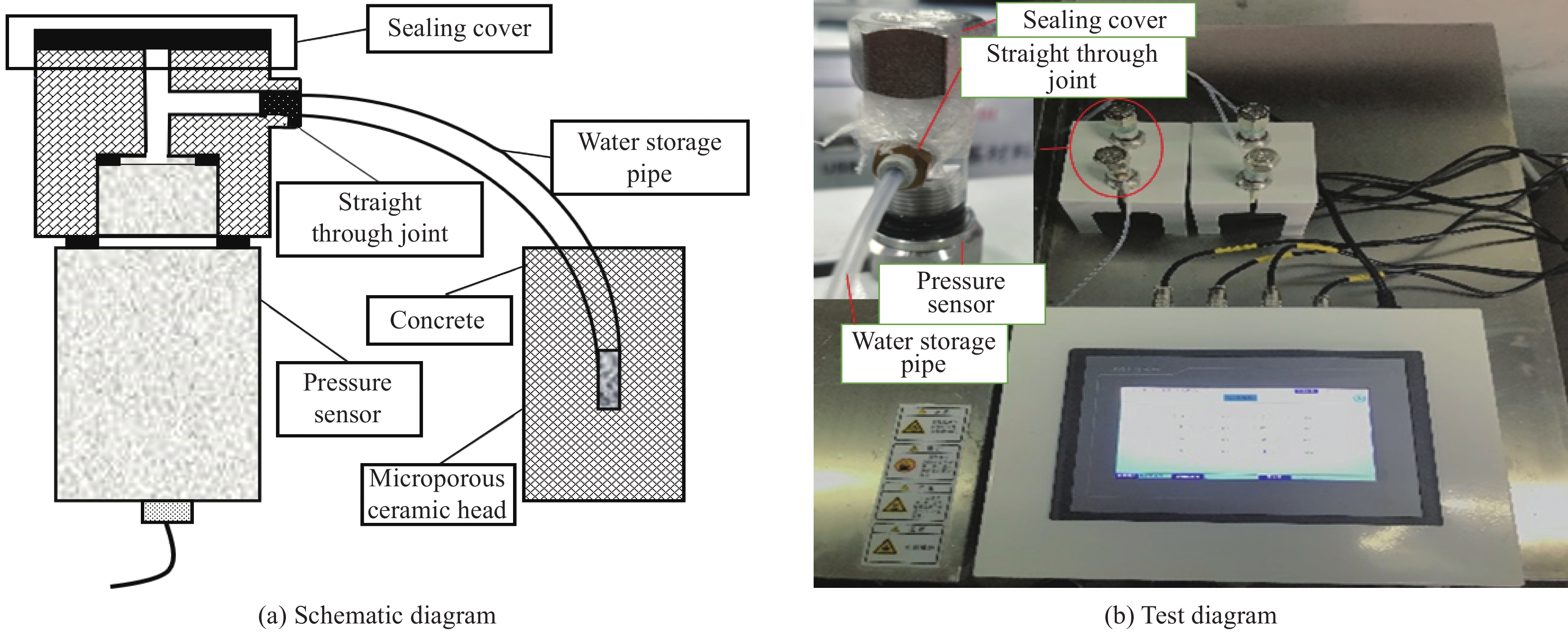Effect of nano C-S-H-PCE on the properties of high-strength non-steam-cured concrete
-
摘要: 针对蒸汽养护易引起混凝土初始损伤及耐久性差等问题。本文采用纳米水化硅酸钙-聚羧酸醚复合材料(n-C-S-H-PCE)制备免蒸养高强混凝土。通过水化热、低场核磁等试验研究了n-C-S-H-PCE对混凝土抗压强度、水化速率、孔径分布、自收缩及耐久性的影响。结果表明:纳米水化硅酸钙(C-S-H)晶核为水化产物提供了成核位点,降低了成核的临界离子浓度Ksp,诱导期和加速期显著提前,显著提高了混凝土早期抗压强度,1天混凝土抗压强度提高64%,且28天以后混凝土没有发生强度倒缩。掺入n-C-S-H-PCE后,混凝土基体孔径细化,凝胶孔和毛细孔比例均增加,导致混凝土自干燥过程中毛细孔负压增大,增大混凝土自收缩;然而,混凝土基体的最可几孔径和50~100 nm孔隙累计体积降低,提高了混凝土的抗氯离子侵蚀性能;孔径大于14 nm (临界孔径)的孔隙含量降低(由0.0287 mL/g降低到0.0156 mL/g),从而提高了混凝土的抗冻性能;此外,掺入n-C-S-H-PCE后,混凝土孔隙率降低,且随着矿粉掺量的增加,铝酸钙相和Ca2+的浓度降低,混凝土抗硫酸盐侵蚀能力提高。该研究为免蒸养、低收缩、高耐久、高强混凝土制备与应用提供了理论依据。Abstract: To solve the initial damage, poor durability, and other problems of concrete caused by steam curing, the nano-hydrated calcium silicate polycarboxylate ether composite (n-C-S-H-PCE) was used to prepare high-strength non-steam-cured concrete. The effects of n-C-S-H-PCE on the compressive strength, hydration rate, pore size distribution, autogenous shrinkage and durability of concrete were studied using hydration heat, low-field nuclear magnetic resonance and other methods. Results show that the crystal nucleus of nano-C-S-H provides nucleation sites for the hydration products of cement, reducing the critical ion concentration Ksp of nucleation. And the induction and acceleration periods are advanced significantly. Also, the early compressive strength of concrete is improved considerably. The compressive strength of concrete increases by 64% after 1 day of curing, and the strength of concrete has no regression after 28 days of curing. The addition of the n-C-S-H-PCE refines the pore size of concrete matrix and increases the proportion of gel pores and capillary pores. As a result, the negative capillary pressure increases during the auto-drying process of concrete. Thus, the autogenous shrinkage of concrete increases. However, the most probable pore size of the concrete matrix and the cumulative volume of pores with a diameter of 50-100 nm decrease. This improves the resistance to chloride migration into concrete. The content of pores with a pore diameter larger than 14 nm (the critical pore diameter) decreases (from 0.0287 mL/g to 0.0156 mL/g). As a result, the freeze-thaw resistance of concrete is improved. The addition of n-C-S-H-PCE can reduce the porosity of concrete. In addition, with the increase of slag content, the concentration of calcium aluminate phase and Ca2+ decreases. In this way, the resistance to sulfate attack of concrete increases. The results provide a theoretical basis for the preparation of non-steam-cured, low shrinkage, high durability and high-strength concrete.
-
Key words:
- nano early strength agent /
- non-steam-cured concrete /
- pore structure /
- autogenous shrinkage /
- durability /
- C-S-H-PCE
-
表 1 水泥和矿粉的化学组成
Table 1. Chemical composition of cement and slag
Material SiO2/wt% Al2O3/wt% Fe2O3/wt% CaO/wt% TiO2/wt% K2O/wt% MgO/wt% SO3/wt% Na2O/wt% Cement 19.94 4.84 2.93 65.71 0.36 0.81 2.93 2.28 0.23 Slag 30.14 15.53 0.43 41.92 0.84 0.46 7.85 2.26 0.56 表 2 混凝土配合比
Table 2. Mix proportion of concrete
Content
of slagSpecimen ID Binder/ (kg·m−3) Cement/ (kg·m−3) Slag/
(kg·m−3)n-C-S-H-PCE/
(kg·m−3)Sand/ (kg·m−3) Aggregate/ (kg·m−3) Water-reducing
agent/(kg·m−3)Water-to binder ratio 20% R-450-20% 450 360 90 0 657 1169 6.75 0.275 R-500-20% 500 400 100 0 637 1133 7.50 0.260 R-550-20% 550 440 110 0 616 1095 8.25 0.252 R-600-20% 600 480 120 0 595 1058 9.00 0.245 30% R-450-30% 450 315 135 0 657 1169 6.75 0.275 R-500-30% 500 350 150 0 637 1133 7.50 0.260 R-550-30% 550 385 165 0 616 1095 8.25 0.252 R-600-30% 600 420 180 0 595 1058 9.00 0.245 20% N-450-20% 450 360 90 18 657 1169 5.40 0.275 N-500-20% 500 400 100 20 637 1133 6.00 0.260 N-550-20% 550 440 110 22 616 1095 6.60 0.252 N-600-20% 600 480 120 24 595 1058 7.20 0.245 30% N-450-30% 450 315 135 18 657 1169 5.40 0.275 N-500-30% 500 350 150 20 637 1133 6.00 0.260 N-550-30% 550 385 165 22 616 1095 6.60 0.252 N-600-30% 600 420 180 24 595 1058 7.20 0.245 Notes: n-C-S-H-PCE—Nano-hydrated calcium silicate polycarboxylate ether; R-450-20% refers to the mix proportion where the amount of cementitious material is 450 kg/m3, the content of slag is 20%, and n-C-S-H-PCE is not added; N-450-30% refers to the mix proportion where the amount of cementitious material is 450 kg/m3, the content of slag is 30%, and 4%n-C-S-H-PCE is added; The representation method of other mix proportion with different the amount of cementitious material is similar to the above. 表 3 不同n-C-S-H-PCE掺量的混凝土自收缩零点
Table 3. Time zero of autogenous shrinkage of concrete with different n-C-S-H-PCE contents
Specimen ID Time zero R-450-20% 6.4 R-600-20% 7.2 R-450-30% 6.2 R-600-30% 7.6 N-450-20% 4.0 N-600-20% 4.6 N-450-30% 4.8 N-600-30% 6.1 表 4 不同n-C-S-H-PCE 掺量的混凝土氯离子扩散系数的拟合参数h和相关性参数R2
Table 4. Fitting parameter h and relevance parameter R2 of coefficient of chloride diffusion of concrete with different n-C-S-H-PCE contents
Sample ID h R2 Sample ID h R2 N-450-20% 0.293 0.989 R-450-20% 0.296 0.992 N-500-20% 0.296 0.992 R-500-20% 0.282 0.991 N-550-20% 0.310 0.983 R-550-20% 0.246 0.982 N-600-20% 0.369 0.985 R-600-20% 0.343 0.999 N-450-30% 0.391 0.985 R-450-30% 0.369 0.997 N-500-30% 0.433 0.986 R-500-30% 0.387 0.982 N-550-30% 0.521 0.999 R-550-30% 0.384 0.981 N-600-30% 0.534 0.997 R-600-30% 0.483 0.999 -
[1] 王鹏刚, 付华, 郭腾飞, 等. 蒸汽养护混凝土变形行为及开裂风险评估[J]. 材料导报, 2022, 36(24):86-93.WANG Penggang, FU Hua, GUO Tengfei, et al. Deformation behavior and cracking risk assessment of steam-cured concrete[J]. Materials Reports,2022,36(24):86-93(in Chinese). [2] LIU J P, TIAN Q, WANG Y, et al. Evaluation method and mitigation strategies for shrinkage cracking of modern concrete[J]. Engineering,2021,7(3):348-357. doi: 10.1016/j.eng.2021.01.006 [3] SUN D, WANG Z, MA R, et al. Autoclave-free ultra-early strength concrete preparation using an early strength agent and microstructure properties[J]. RSC Advances,2021,11(28):17369-17376. doi: 10.1039/D1RA01611C [4] TAN H B, LI M G, HE X Y, et al. Preparation for micro-lithium slag via wet grinding and its application as accelerator in portland cement[J]. Journal of Cleaner Production,2020,250:119528. doi: 10.1016/j.jclepro.2019.119528 [5] 余鑫, 于诚, 姜骞, 等. 采用原位XRD研究早强剂对水泥早期水化的影响[J]. 材料导报, 2020, 34(2):2058-2062. doi: 10.11896/cldb.19010051YU Xin, YU Cheng, JIANG Sai, et al. Study on the effect of early strength agent on early hydration of cement by in-situ XRD[J]. Materials Reports,2020,34(2):2058-2062(in Chinese). doi: 10.11896/cldb.19010051 [6] NGUYEN H A, CHANG T P, THYMOTIE A. Enhancement of early engineering characteristics of modified slag cement paste with alkali silicate and sulfate[J]. Construction and Building Materials,2020,230:117013. doi: 10.1016/j.conbuildmat.2019.117013 [7] HOU P K, KAWASHIMA S H, KONG D Y, et al. Modification effects of colloidal nano SiO2 on cement hydration and its gel property[J]. Composites Part B: Engineering,2013,45(1):440-448. doi: 10.1016/j.compositesb.2012.05.056 [8] ZOU F B, HU C L, WANG F Z. Enhancement of early-age strength of the high content fly ash blended cement paste by sodium sulfate and C-S-H seeds towards a greener binder[J]. Journal of Cleaner Production,2020,244:118566. doi: 10.1016/j.jclepro.2019.118566 [9] KANCHANASON V, PLANK J. Effect of calcium silicate hydrate-polycarboxylate ether (C-S-H-PCE) nanocomposite as accelerating admixture on early strength enhancement of slag and calcined clay blended cements[J]. Cement and Concrete Research,2019,119:44-50. doi: 10.1016/j.cemconres.2019.01.007 [10] WYRZYKOWSKI M, ASSMANN A, HESSE C, et al. Microstructure development and autogenous shrinkage of mortars with C-S-H seeding and internal curing[J]. Cement and Concrete Research,2020,129:105967. doi: 10.1016/j.cemconres.2019.105967 [11] LI X, BIZZOZERO J, HESSE C. Impact of C-S-H seeding on hydration and strength of slag blended cement[J]. Cement and Concrete Research,2022,161:106935. doi: 10.1016/j.cemconres.2022.106935 [12] 中国建筑材料联合会. 预应力高强混凝土管桩免压蒸生产技术要求: T/CBMF 64—2019[S]. 北京: 中国建筑工业出版社, 2019.China Building Materials Federation. Technical requirements for the no-autoclave curing production process of prestressed high-strength concrete pipe pile: T/CBMF 64—2019[S]. Beijing: China Construction Industry Press, 2019(in Chinese). [13] 中华人民共和国住房和城乡建设部. 混凝土结构耐久性设计标准: GB/T 50476—2019[S]. 北京: 中国建筑工业出版社, 2019.Ministry of Housing and Urban-Rural Development of the People's Republic of China. Standard for durability design of concrete structures: GB/T 50476—2019[S]. Beijing: China Construction Industry Press, 2019(in Chinese). [14] 严涵, 杨斌, 杨勇, 等. 一种水化硅酸钙早强剂及其制备方法: 中国专利, ZL 201911281804.2[P]. 2022-09-20.YAN Han, YANG Bin, YANG Yong, et al. A hydrated calcium silicate early strength agent and its preparation method: Chinese patent, ZL 201911281804.2[P]. 2022-09-20(in Chinese). [15] ZHAO H T, JIANG K D, YANG R, et al. Experimental and theoretical analysis on coupled effect of hydration, temperature and humidity in early-age cement-based materials[J]. International Journal of Heat and Mass Transfer,2020,146:118748. [16] ZHAO H T, WU X, HUANG Y Y, et al. Investigation of moisture transport in cement-based materials using low-field nuclear magnetic resonance imaging[J]. Magazine of Concrete Research,2021,73(5):252-270. doi: 10.1680/jmacr.19.00211 [17] SHE A M, YAO W, YUAN W C. Evolution of distribution and content of water in cement paste by low field nuclear magnetic resonance[J]. Journal of Central South University,2013,20(4):1109-1114. doi: 10.1007/s11771-013-1591-y [18] 中华人民共和国住房和城乡建设部. 普通混凝土力学性能试验方法标准: GB/T 50081—2002[S]. 北京: 中国建筑工业出版社, 2002.Ministry of Housing and Urban-Rural Development of the People's Republic of China. Standard for test methods of mechanical properties of ordinary concrete: GB/T 50081—2002[S]. Beijing: China Construction Industry Press, 2002(in Chinese). [19] 中华人民共和国住房和城乡建设部. 普通混凝土长期性能和耐久性能试验方法标准: GB/T 50082—2009[S]. 北京: 中国建筑工业出版社, 2009.Ministry of Housing and Urban-Rural Development of the People's Republic of China. Standard for long-term performance and durability test method of ordinary concrete: GB/T 50082—2009[S]. Beijing: China Construction Industry Press, 2009(in Chinese). [20] 王晓飞, 李秋义, 罗健林, 等. 不同品质再生粗骨料混凝土的力学性能及鲍罗米公式拟合[J]. 混凝土, 2016(3):60-64.WANG Xiaofei, LI Qiuyi, LUO Jianlin, et al. Mechanical properties and Bowromi formula regression for recycled coarse aggregate concrete with different quality[J]. Concrete,2016(3):60-64(in Chinese). [21] QIN L, GAO X J, SU A S, et al. Effect of carbonation curing on sulfate resistance of cement-coal gangue paste[J]. Journal of Cleaner Production,2021,278:123897. doi: 10.1016/j.jclepro.2020.123897 [22] KANCHANASON V, PLANK J. Effectiveness of a calcium silicate hydrate-polycarboxylate ether (CSH-PCE) nanocomposite on early strength development of fly ash cement[J]. Construction and Building Materials,2018,169:20-27. doi: 10.1016/j.conbuildmat.2018.01.053 [23] EBRAHIMI K, DAIEZADEH M J, ZAKERTABRIZI M, et al. A review of the impact of micro-and nanoparticles on freeze-thaw durability of hardened concrete: Mechanism perspective[J]. Construction and Building Materials,2018,186:1105-1113. doi: 10.1016/j.conbuildmat.2018.08.029 [24] LI J, KAUNDA R B, ZHOU K. Experimental investigations on the effects of ambient freeze-thaw cycling on dynamic properties and rock pore structure deterioration of sandstone[J]. Cold Regions Science and Technology,2018,154:133-141. doi: 10.1016/j.coldregions.2018.06.015 [25] JENSEN O M. Thermodynamic limitation of self-desiccation[J]. Cement and Concrete Research,1995,25(1):157-164. doi: 10.1016/0008-8846(94)00123-G [26] JENSEN O M, HANSEN P F. Influence of temperature on autogenous deformation and relative humidity change in hardening cement paste[J]. Cement and Concrete Research,1999,29(4):567-575. doi: 10.1016/S0008-8846(99)00021-6 [27] WANG P, FU H, GUO T, et al. Volume deformation of steam-cured concrete with fly ash during and after steam curing[J]. Construction and Building Materials,2021,306:124854. doi: 10.1016/j.conbuildmat.2021.124854 [28] ZUO W, FENG P, ZHONG P, et al. Effects of a novel polymer-type shrinkage-reducing admixture on early age microstructure evolution and transport properties of cement pastes[J]. Cement and Concrete Composites,2019,95:33-41. doi: 10.1016/j.cemconcomp.2018.10.011 [29] 缪昌文, 田倩, 刘加平, 等. 基于毛细管负压技术测试混凝土最早期的自干燥效应[J]. 硅酸盐学报, 2007, 35(4):509-516.MIAO Changwen, TIAN Qian, LIU Jiaping, et al. Very early age self-desiccation effect measurement based on meniscus depression technology for concrete[J]. Journal of Chinese Ceramic Society,2007,35(4):509-516(in Chinese). [30] DANISH A, MOSABERPANAH M A, SALIM M U. Robust evaluation of superabsorbent polymers as an internal curing agent in cementitious composites[J]. Journal of Materials Science,2021,56(1):136-172. doi: 10.1007/s10853-020-05131-2 [31] WITTMANN F. On the action of capillary pressure in fresh concrete[J]. Cement and Concrete Research,1976,6(1):49-56. doi: 10.1016/0008-8846(76)90050-8 [32] SLOWIK V, SCHMIDT M, FRITZSCH R. Capillary pressure in fresh cement-based materials and identification of the air entry value[J]. Cement and Concrete Composites,2008,30(7):557-565. doi: 10.1016/j.cemconcomp.2008.03.002 [33] YE H L, RADLINSKA A. Shrinkage mitigation strategies in alkali-activated slag[J]. Cement and Concrete Research,2017,101:131-143. doi: 10.1016/j.cemconres.2017.08.025 [34] VLAHINIC I, JENNINGS H M, THOMAS J J. A constitutive model for drying of a partially saturated porous material[J]. Mechanics of Materials,2009,41(3):319-328. doi: 10.1016/j.mechmat.2008.10.011 [35] CHOI S W, JANG B S, KIM J H, et al. Durability characteristics of fly ash concrete containing lightly-burnt MgO[J]. Construction and Building Materials,2014,58:77-84. doi: 10.1016/j.conbuildmat.2014.01.080 [36] ZHAO L, CHENG G D, DING Y J. Studies on frozen ground of China[J]. Journal of Geographical Sciences,2004,14(4):411-416. doi: 10.1007/BF02837484 [37] POWERS T C. Freezing effects in concrete[J]. Special Publication,1975,47:1-12. [38] POWERS T C, HELMUTH R A. A tribute to "Theory of volume changes in hardened portland-cement paste during freezing"[J]. Special Publication,2008,249:141-160. [39] SCHERER G W. Crystallization in pores[J]. Cement and Concrete Research,1999,29(8):1347-1358. doi: 10.1016/S0008-8846(99)00002-2 [40] XIAO Z, LAI Y, ZHANG M. Study on the freezing temperature of saline soil[J]. Acta Geotechnica,2018,13(1):195-205. doi: 10.1007/s11440-017-0537-1 [41] IDIART A E, LOPEZ C M, CAROL I. Chemo-mechanical analysis of concrete cracking and degradation due to external sulfate attack: A meso-scale model[J]. Cement and Concrete Composites,2011,33(3):411-423. doi: 10.1016/j.cemconcomp.2010.12.001 [42] SUN D, WU K, SHI H, et al. Effect of interfacial transition zone on the transport of sulfate ions in concrete[J]. Construction and Building Materials,2018,192:28-37. doi: 10.1016/j.conbuildmat.2018.10.140 [43] TAYLOR H F. Cement chemistry[M]. New York: Thomas Telford London, 1997: 235-297. -






 下载:
下载:























